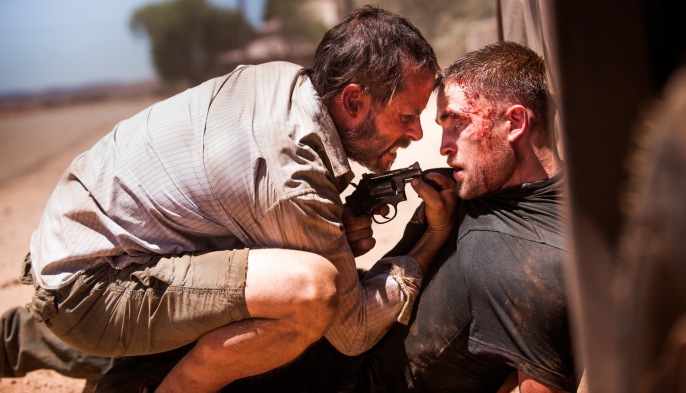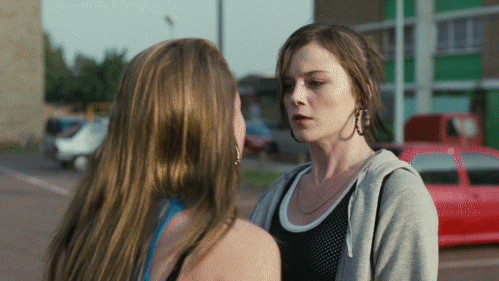Consider this post a witches’ brew. The contents started as a liquid composed of every crime, thriller and horror feature on Netflix Instant. Then I cranked up the heat and gave it a year-long simmer, meticulously skimming away the fat and nasty bits. After that, I spent the next three months tasting and testing till I finally had a small saucepan of the darkest, most delectable demi-glace. I then took that shit and poured it over the finest unicorn liver and paired it with a nice barrel of chianti. And now… Dinner is served, cabrones!
Wait. Did you catch all that?
Essentially what I’m saying is that I spent a year combing through Reddit subthreads, countless hours watching every imaginable film and series on Netflix Instant, and three months writing about my favorite lesser-known titles (along with the help of my partner-in-crime, Adam Fox). I’ve now condensed all this research into a list of 18 of the best horror, crime and thriller features that you may have not seen on Netflix Instant.
Are a few things missing? Sure. No list is definitive, and that’s what next year is for. But consider this a damn good menu, with every item coming highly recommended by the chef himself.
Here’s the list, graded and alphabetically ordered, with titles linking back to our initial long-form posts:
MOVIES

Blue Ruin
 Bittersweet revenge. That’s what Dwight (Macon Blair), a dumpster-diving hobo, is after when he hears the man who killed his parents is getting out of prison. Blue Ruin delivers as one of the most beautifully shot, darkly comical and poignant films of 2013. If you liked Shotgun Stories or are simply a fan of revenge and vigilante justice flicks, look no further. B+/A-
Bittersweet revenge. That’s what Dwight (Macon Blair), a dumpster-diving hobo, is after when he hears the man who killed his parents is getting out of prison. Blue Ruin delivers as one of the most beautifully shot, darkly comical and poignant films of 2013. If you liked Shotgun Stories or are simply a fan of revenge and vigilante justice flicks, look no further. B+/A-
Fish Tank
 A charming Irishman enters the life of a teenage breakdancer who lives with her drunk mom and foul-mouthed sister in the slums of East London. Michael Fassbender (pre-Magneto fame) provides one of his best ever performances as a boozy savior who seems too good to be true. This film creates a riveting wave of suspense, despite being the only title on this list devoid of much action or overt violence. A-
A charming Irishman enters the life of a teenage breakdancer who lives with her drunk mom and foul-mouthed sister in the slums of East London. Michael Fassbender (pre-Magneto fame) provides one of his best ever performances as a boozy savior who seems too good to be true. This film creates a riveting wave of suspense, despite being the only title on this list devoid of much action or overt violence. A-
God Bless America
 Idiocracy and the 1970 hippie-slaughter-fest Joe meet Network in Bobact Goldthwait’s blacker-than-black satire on American media culture and narcissism. Bill Murray’s brother, Joel, is phenomenal as an everyman who finally hits his breaking point and goes on a monstrous killing spree… inspired by human compassion. B+/A-
Idiocracy and the 1970 hippie-slaughter-fest Joe meet Network in Bobact Goldthwait’s blacker-than-black satire on American media culture and narcissism. Bill Murray’s brother, Joel, is phenomenal as an everyman who finally hits his breaking point and goes on a monstrous killing spree… inspired by human compassion. B+/A-
Gomorrah
 Fucking hell, this is a bleak one. Director Matteo Garrone takes a page from Alejandro González Iñárritu’s book and intertwines four slum tales, using the gang-ridden streets of Naples as his canvas. Ranked by A.O. Scott as the sixth-best film of 2008, I’d highly recommend this to fans of Amores Perros and City of God. B+
Fucking hell, this is a bleak one. Director Matteo Garrone takes a page from Alejandro González Iñárritu’s book and intertwines four slum tales, using the gang-ridden streets of Naples as his canvas. Ranked by A.O. Scott as the sixth-best film of 2008, I’d highly recommend this to fans of Amores Perros and City of God. B+
Headhunters
 This fast-paced Norwegian thriller tells the story of an art thief who gets in over his head by stealing from a special ops manhunter. Said manhunter is Game of Thrones‘ Nikolaj Coster-Waldau, who brings all his kingslaying charm to what is perhaps the most throughly entertaining movie I watched all year. A-
This fast-paced Norwegian thriller tells the story of an art thief who gets in over his head by stealing from a special ops manhunter. Said manhunter is Game of Thrones‘ Nikolaj Coster-Waldau, who brings all his kingslaying charm to what is perhaps the most throughly entertaining movie I watched all year. A-
In Bruges
 Like I said, “mostly lesser-known” titles. If you haven’t seen Martin McDonagh’s brilliantly wry flick about a pair of hitmen (Colin Farrell and Brendan Gleeson) holidaying in the “fucking fairytale” town of Bruges, consider this a must-watch. For those who have seen it, I cannot urge you strongly enough to seek out The Guard, starring Brendan Gleeson as a Bad Lieutenant-esque Irish cop. (I’m quite eagerly anticipating director John Michael McDonagh’s follow-up, Calvary, which hits Netflix DVD queues on Jan. 6). A-
Like I said, “mostly lesser-known” titles. If you haven’t seen Martin McDonagh’s brilliantly wry flick about a pair of hitmen (Colin Farrell and Brendan Gleeson) holidaying in the “fucking fairytale” town of Bruges, consider this a must-watch. For those who have seen it, I cannot urge you strongly enough to seek out The Guard, starring Brendan Gleeson as a Bad Lieutenant-esque Irish cop. (I’m quite eagerly anticipating director John Michael McDonagh’s follow-up, Calvary, which hits Netflix DVD queues on Jan. 6). A-
El Infierno
 The best lesser-known movie on Netflix Instant. Period. A Mexican man is deported back home from the States, only to find his nation in ruinous drug violence. So what does he do? Break bad and become a narco hitman, of course. Rarely is sociopolitical commentary as entertaining to watch as in director Luis Estrada’s masterpiece. My top recommendation on this list—which would explain why I wrote a fucking novella on it (see link). A
The best lesser-known movie on Netflix Instant. Period. A Mexican man is deported back home from the States, only to find his nation in ruinous drug violence. So what does he do? Break bad and become a narco hitman, of course. Rarely is sociopolitical commentary as entertaining to watch as in director Luis Estrada’s masterpiece. My top recommendation on this list—which would explain why I wrote a fucking novella on it (see link). A
I Saw the Devil
 I didn’t write about Oldboy because if you’re reading this, chances are you’ve seen it thirteen times. I Saw the Devil continues in the tradition of Park Chan-Wook’s gut-wrenchingly violent Vengeance Trilogy and is, with perhaps the exception of Oldboy, the best film made in the landscape of prolific gore-horror that is South Korean cinema. Alongside El Infierno and Tell No One, this rounds out my top three recommendations within this list. A-/A
I didn’t write about Oldboy because if you’re reading this, chances are you’ve seen it thirteen times. I Saw the Devil continues in the tradition of Park Chan-Wook’s gut-wrenchingly violent Vengeance Trilogy and is, with perhaps the exception of Oldboy, the best film made in the landscape of prolific gore-horror that is South Korean cinema. Alongside El Infierno and Tell No One, this rounds out my top three recommendations within this list. A-/A
Let the Right One In
 This Swedish kiddie vampire tale makes Twilight look like Sesame Street. If for some reason you haven’t seen this, please do—it’s arguably one of the best horror movies ever made. A
This Swedish kiddie vampire tale makes Twilight look like Sesame Street. If for some reason you haven’t seen this, please do—it’s arguably one of the best horror movies ever made. A
The Man from Nowhere
 At what what point do I just give up and dedicate my entire blog to South Korean revenge movies? That’s a question this grim story of a mysterious Asian Jason Bourne putting his life on the line to save a young girl brings to mind. While not quite as devastatingly sinister as The Vengeance Trilogy, director Lee Jeong-beom’s 2010 flick is every bit as good—and much more action-packed. B+/A-
At what what point do I just give up and dedicate my entire blog to South Korean revenge movies? That’s a question this grim story of a mysterious Asian Jason Bourne putting his life on the line to save a young girl brings to mind. While not quite as devastatingly sinister as The Vengeance Trilogy, director Lee Jeong-beom’s 2010 flick is every bit as good—and much more action-packed. B+/A-
Stake Land
 Aside from Let the Right One In, it could be argued that this devilish, little vampire road movie is the best bloodsucker flick since Dusk Till Dawn. It’s basically a much smarter, more artfully crafted and fully realized version of The Walking Dead. Oh, and while we’re on the subject of vamps, do me a fucking favor and skip that hipster trash that hipster critics are raving about, Only Lovers Left Alive. I consider Jim Jarmusch a god among directors, but that was his most pretentious bit of bullshit ever. On a more upbeat note, keep an eye out for the Iranian flick A Girl Walks Home Alone at Night, which I nominate for best horror-film title of 2014. As for Stake Land… A-
Aside from Let the Right One In, it could be argued that this devilish, little vampire road movie is the best bloodsucker flick since Dusk Till Dawn. It’s basically a much smarter, more artfully crafted and fully realized version of The Walking Dead. Oh, and while we’re on the subject of vamps, do me a fucking favor and skip that hipster trash that hipster critics are raving about, Only Lovers Left Alive. I consider Jim Jarmusch a god among directors, but that was his most pretentious bit of bullshit ever. On a more upbeat note, keep an eye out for the Iranian flick A Girl Walks Home Alone at Night, which I nominate for best horror-film title of 2014. As for Stake Land… A-
Tell No One
 Michael Caine named this 2006 French mystery thriller as one of the top ten movies ever made. While I don’t fully agree, I also wouldn’t call that hyperbole. This story—about a doctor who uncovers a secret about his dead wife—somehow manages the task of being both one of the most beautiful love stories and most action-packed thrillers in recent memory. One of my top three picks on this list. A
Michael Caine named this 2006 French mystery thriller as one of the top ten movies ever made. While I don’t fully agree, I also wouldn’t call that hyperbole. This story—about a doctor who uncovers a secret about his dead wife—somehow manages the task of being both one of the most beautiful love stories and most action-packed thrillers in recent memory. One of my top three picks on this list. A
The Taking of Deborah Logan
 The found-footage genre finds new life in this jump-out-your-seat scary flick about a lady with Alzheimer’s who becomes possessed by demonic forces. While my smug, Masshole co-writer Adam Fox may disagree, I’d easily call this one of the best horror movies of 2014. B+/A-
The found-footage genre finds new life in this jump-out-your-seat scary flick about a lady with Alzheimer’s who becomes possessed by demonic forces. While my smug, Masshole co-writer Adam Fox may disagree, I’d easily call this one of the best horror movies of 2014. B+/A-
You’re Next
 An Australian survivalist chick winds up at the dinner party from hell as a cast and crew of mumblecore jag-offs redeem themselves by creating one of the best slasher films in years. If there was any justice in this world, Dwight Twilley would win an Oscar for “Looking for the Magic”—which director Adam Wingard uses immaculately here. B+/A-
An Australian survivalist chick winds up at the dinner party from hell as a cast and crew of mumblecore jag-offs redeem themselves by creating one of the best slasher films in years. If there was any justice in this world, Dwight Twilley would win an Oscar for “Looking for the Magic”—which director Adam Wingard uses immaculately here. B+/A-
SERIES

Black Mirror
 Did I just give a shout-out to Adam Fox? He’s the guy who’s been writing up Black Mirror for this here site. Charlie Brooker’s series of seven (so far) unrelated stories is a menacingly bleak futuristic take on technology, dystopia and human fallibility. So far we’ve posted on Fifteen Million Merits (B+), a glimpse of what happens when The Running Man meets American Idol in hell; and The National Anthem (A-), which deals with a British prime minister deciding whether he should follow through on a terrorist threat to fuck a pig.
Did I just give a shout-out to Adam Fox? He’s the guy who’s been writing up Black Mirror for this here site. Charlie Brooker’s series of seven (so far) unrelated stories is a menacingly bleak futuristic take on technology, dystopia and human fallibility. So far we’ve posted on Fifteen Million Merits (B+), a glimpse of what happens when The Running Man meets American Idol in hell; and The National Anthem (A-), which deals with a British prime minister deciding whether he should follow through on a terrorist threat to fuck a pig.
Happy Valley
 If you haven’t watched Happy Valley yet, perhaps it’s for some of the same reasons that it took me so long to get around to it: The marquee image on Netflix displays an unknown, middle-aged actress in a British cop uniform. Meanwhile, there are several other British series plastered on the same page containing well-known actors in their prime, like Idris Elba, Cillian Murphy and Benedict Cumbertwat. So why should you choose Happy Valley, a show about a small-town detective who gets involved in a high-stakes kidnapping case? Let the record state that I am not comparing it to Breaking Bad… but it is the best show I’ve seen since the best show ever made ended. That’s why. A
If you haven’t watched Happy Valley yet, perhaps it’s for some of the same reasons that it took me so long to get around to it: The marquee image on Netflix displays an unknown, middle-aged actress in a British cop uniform. Meanwhile, there are several other British series plastered on the same page containing well-known actors in their prime, like Idris Elba, Cillian Murphy and Benedict Cumbertwat. So why should you choose Happy Valley, a show about a small-town detective who gets involved in a high-stakes kidnapping case? Let the record state that I am not comparing it to Breaking Bad… but it is the best show I’ve seen since the best show ever made ended. That’s why. A
The Fall: Season One
 The Fall is perhaps one of the most intelligent cop shows on TV this side of True Detective, and now that Rust and Marty are out of the picture, Gillian Anderson’s lead as icy investigator Stella Gibson is perhaps the best character in the genre. The only downfall of this first season—which trails a sadistic Belfast serial killer—is that it left us with an asshole of a cliffhanger. Quit dicking around, BBC—deliver the goods! A-
The Fall is perhaps one of the most intelligent cop shows on TV this side of True Detective, and now that Rust and Marty are out of the picture, Gillian Anderson’s lead as icy investigator Stella Gibson is perhaps the best character in the genre. The only downfall of this first season—which trails a sadistic Belfast serial killer—is that it left us with an asshole of a cliffhanger. Quit dicking around, BBC—deliver the goods! A-
Peaky Blinders: Season One
 “When you walk through the garden…”. That was the line that Tom Waits opened episodes of The Wire with. “Take a little walk to the other side of the tracks” is the line Nick Cave opens Peaky Blinders with, and his “Red Right Hand” is the best intro song to any show since David Simon’s deservedly heralded series. There’s also a lot of other awesome shit happening here, like Cillian Murphy—as the leader of a Birmingham street gang—slashing people’s faces with razor-embedded scally caps. Blinders isn’t the most highbrow fare, but its first season is one of the most entertaining pieces of television I’ve seen in years. The second season falls a little short, but that’s another story for another time. A-
“When you walk through the garden…”. That was the line that Tom Waits opened episodes of The Wire with. “Take a little walk to the other side of the tracks” is the line Nick Cave opens Peaky Blinders with, and his “Red Right Hand” is the best intro song to any show since David Simon’s deservedly heralded series. There’s also a lot of other awesome shit happening here, like Cillian Murphy—as the leader of a Birmingham street gang—slashing people’s faces with razor-embedded scally caps. Blinders isn’t the most highbrow fare, but its first season is one of the most entertaining pieces of television I’ve seen in years. The second season falls a little short, but that’s another story for another time. A-
-Sam Adams
NOTE: A big year-end thanks to everyone who’s patronized this site, commented on it and given their support over the past three months. It means the fucking world. Also, a huge thanks to my man Adam Fox for helping me keep the ship afloat. We’ve got much more in store for 2015!














































